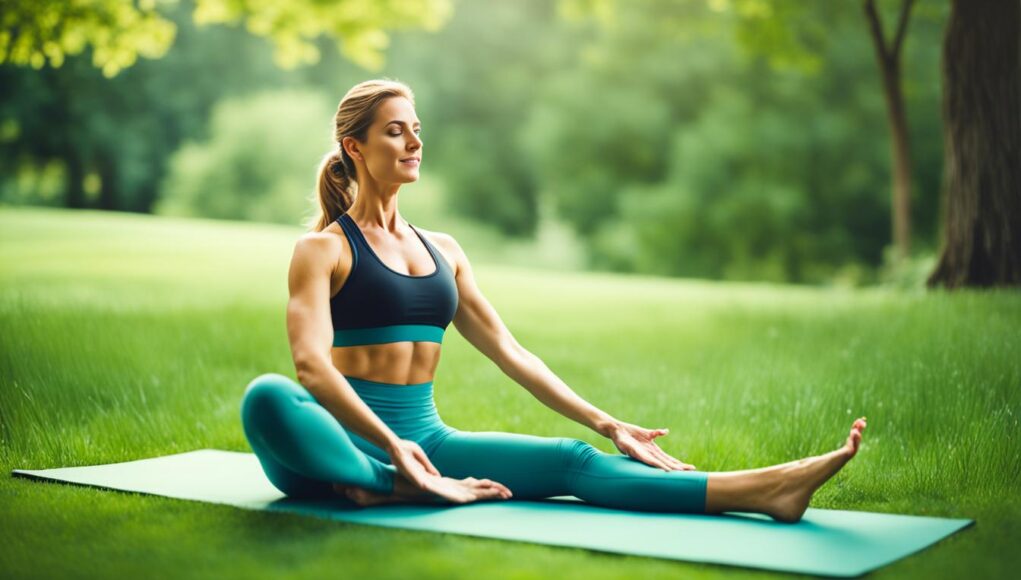Are you ready to transform your life and embrace a state of well-being? Look no further than the power of yoga. This ancient practice not only strengthens your body but also nurtures your mind and spirit. But where do you begin? What are the essential elements you need to fully immerse yourself in the world of yoga? And how can mindfulness and positivity play a role in your journey?
Join us as we unravel the secrets of yoga essentials and dive into the core benefits of regular practice. Discover how cultivating a yoga mindset can bring about lasting change and enhance your overall well-being. Whether you’re a beginner or an experienced practitioner, this article will guide you through the journey of revitalizing your life with yoga.
Key Takeaways:
- Yoga is a transformative practice that revitalizes your body, mind, and spirit.
- Understanding the essentials of yoga is crucial for beginners to embark on their journey.
- Regular yoga practice brings physical enhancement, mental clarity, and stress reduction.
- Cultivating a yoga mindset through mindfulness and positivity is essential for lasting change.
- Finding the right yoga instructor and studio can support and enrich your yoga practice.
Embracing Yoga for a Transformative Experience
Yoga is not just a physical exercise; it is a transformative journey that can profoundly impact the mind, body, and spirit. From the moment you step onto the mat, you embark on a path of self-discovery and personal growth. In this section, we will explore the various stages of the yoga journey and the profound benefits that can be experienced along the way.
Understanding the Yoga Journey
The yoga journey unfolds in stages, starting with the initial exploration of the practice and progressing towards mastery. Each stage offers unique insights, challenges, and rewards, allowing you to uncover new layers of self-awareness and tap into your hidden potential. Whether you are a beginner or an advanced practitioner, there is always room for growth and self-discovery on the yoga path.
The Role of Consistency in Yoga Practice
Consistency is key when it comes to reaping the full benefits of yoga. Regular practice not only builds strength, flexibility, and balance but also enhances the mind-body connection and promotes inner peace. By committing to a consistent yoga practice, you create a space for transformation and personal evolution. Embracing yoga as a lifestyle and dedicating yourself to regular practice can truly unlock the transformative power of this ancient practice.
| Stage | Key Benefits |
|---|---|
| Beginner | – Increased body awareness – Improved flexibility and strength – Enhanced mental clarity |
| Intermediate | – Deepened focus and concentration – Advanced poses and transitions – Stress reduction and emotional well-being |
| Advanced | – Peak physical fitness and stamina – Refinement in advanced poses – Spiritual growth and self-realization |
No matter where you are in your yoga journey, consistency in practice will amplify the benefits and allow you to experience the transformative power of yoga to its fullest extent.
“Yoga is the journey of the self, through the self, to the self.” – The Bhagavad Gita
Yoga Essentials for Beginners
As you embark on your yoga journey, it’s important to equip yourself with the right essentials to enhance your practice. Whether you’re a beginner or have some experience, having the necessary equipment and clothing can make a world of difference in your yoga sessions. Let’s dive into the essential items you’ll need to get started on your yoga adventure.
The Right Yoga Mat
An essential element of a successful yoga practice is a good quality yoga mat. When choosing a yoga mat, consider factors such as thickness, grip, and durability. Opt for a mat with sufficient cushioning to support your joints and ensure comfort during various poses. Look for a non-slip surface that provides traction to prevent slipping and sliding. Additionally, make sure to choose a mat that suits your preferred style of yoga, whether it’s hot yoga, gentle flow, or power yoga.
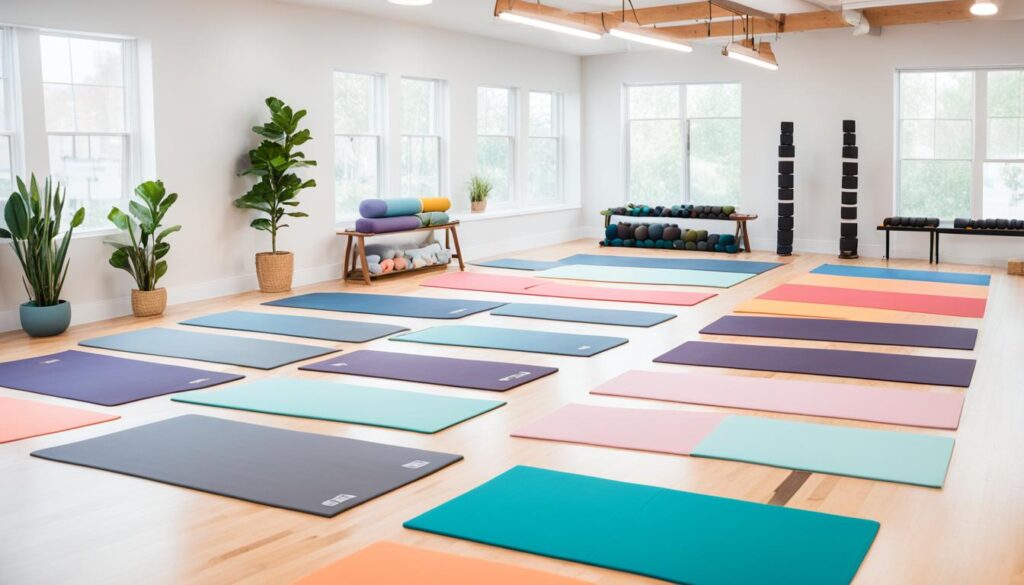
Comfortable Clothing
Wearing comfortable clothing is key to allowing freedom of movement and maintaining focus during your yoga practice. Opt for breathable, stretchy fabrics that allow for unrestricted movement. Choose clothing that fits well and doesn’t restrict your range of motion. Whether you prefer leggings, shorts, or loose-fitting pants, prioritize comfort above all else.
The Essential Accessories
In addition to a yoga mat and comfortable clothing, there are a few accessories that can enhance your yoga experience. A yoga strap is a versatile tool that helps with stretching and deepening your poses. It can also aid in achieving proper alignment. Yoga blocks are another useful accessory, providing stability and support during challenging poses. These props are especially beneficial for beginners as they assist in building strength and flexibility.
Lastly, don’t forget to bring a water bottle to stay hydrated throughout your practice. Hydration is essential for maintaining energy and performance during your yoga sessions.
Now that you have an understanding of the yoga essentials for beginners, you’re well-prepared to start your yoga practice with confidence. Remember, investing in high-quality equipment and comfortable clothing will contribute to a positive and enjoyable yoga experience.
Core Benefits of Regular Yoga Practice
Incorporating regular yoga practice into your daily routine offers a multitude of benefits for both the body and the mind. The physical enhancements gained from yoga include improved strength, flexibility, and balance. By engaging in a variety of yoga poses and flows, you can strengthen your muscles, increase your range of motion, and improve your overall physical fitness.
Beyond the physical benefits, yoga also provides mental clarity and stress reduction. Through the practice of breath control and mindfulness, yoga helps calm the mind and reduce anxiety and stress. Regular yoga practice allows you to cultivate a sense of mental calmness and focus, enhancing your ability to handle daily challenges and promote overall well-being.
The Yoga Mindset: Cultivating Mindfulness and Positivity
In the world of yoga, cultivating a mindset of mindfulness and positivity is essential for experiencing the true transformative power of the practice. By embracing these elements, practitioners can deepen their connection with themselves and the present moment, allowing for greater self-awareness and well-being. To truly embody the yoga mindset, it is important to integrate meditation into your yoga routine and embrace specific mindful yoga techniques that foster a positive mindset.
Integrating Meditation into Your Yoga Routine
Meditation is a key component of the yoga practice and plays a vital role in cultivating mindfulness. By dedicating time to quiet the mind and focus inward, practitioners can deepen their connection with the present moment and enhance their overall sense of well-being. To integrate meditation into your yoga routine, set aside a few minutes before or after your physical practice. Find a comfortable seated position, close your eyes, and bring your attention to your breath. Allow thoughts to come and go without judgment, simply observing them as they arise. Over time, regular meditation practice will help quiet the mind, reduce stress, and increase mental clarity.
Embracing the Present with Mindful Yoga Techniques
In addition to meditation, there are specific mindful yoga techniques that can enhance your ability to stay present and cultivate a positive mindset. One such technique is conscious breathing, where you bring your awareness to your breath throughout your practice. Focus on the sensation of each inhale and exhale, allowing it to anchor you in the present moment.
“The pose begins when you want to leave it.”
This quote by renowned yoga teacher Baron Baptiste reminds us to stay fully present in each pose, even when it becomes challenging. Embracing this mantra and focusing on your breath can help you cultivate resilience and a positive mindset, both on and off the mat.
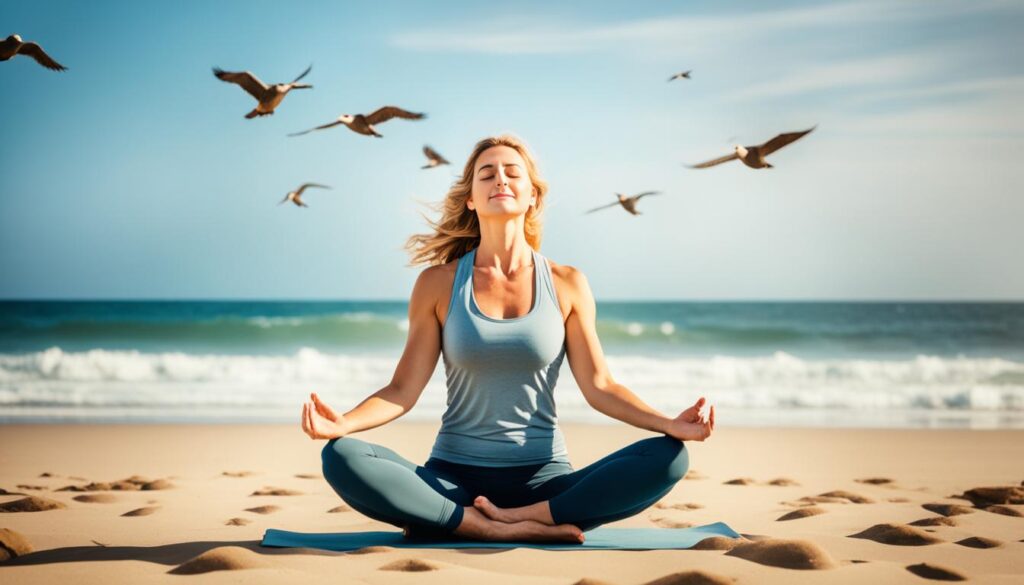
Incorporating gratitude into your practice is another mindful technique that can shift your mindset and bring positivity into your life. Take a moment before or after your practice to express gratitude for your body, your breath, and the opportunity to practice yoga. This simple act of gratitude can foster a sense of joy and appreciation that ripples into every aspect of your life.
| Mindful Yoga Techniques | Benefits |
|---|---|
| Conscious breathing | Enhances presence and awareness |
| Embracing challenges in poses | Cultivates resilience and a positive mindset |
| Practicing gratitude | Brings positivity and joy into your life |
Yoga
Welcome to the world of yoga! In this section, we will provide you with a general overview and introduction to yoga, a practice that has its roots in ancient India and has now gained worldwide popularity. Yoga is not just a physical exercise, but a holistic practice that combines movement, breathwork, mindfulness, and meditation to promote physical, mental, and spiritual well-being.
Yoga offers a wide range of benefits, from increased flexibility and strength to reduced stress and improved focus. It is a practice that can be enjoyed by people of all ages and fitness levels, with different styles and types of yoga available to cater to individual preferences and goals.
There are various styles of yoga, including hatha, vinyasa, ashtanga, bikram, and more. Each style has its own unique characteristics and focuses on different aspects of the practice, such as movement, alignment, breath control, or meditation. It’s important to find a style that resonates with you and matches your interests and objectives.
Whether you prefer a gentle and slow-paced practice or a dynamic and challenging one, there is a yoga class out there that suits your needs. Attending yoga classes can provide you with guidance, support, and the opportunity to learn from experienced instructors. It can also help you stay motivated and committed to your yoga practice.
If attending in-person classes is not feasible, there are also many online yoga classes available that allow you to practice in the comfort of your own home. Online classes offer convenience and flexibility, allowing you to choose the time and location that work best for you.
In the next section, we will delve into the qualities to look for in a yoga instructor and the importance of finding the right yoga studio to support your practice. So get ready to take your first steps on the yoga mat and embark on a transformative journey of self-discovery and well-being!
Finding the Right Yoga Instructor and Studio
Making the decision to start a yoga practice is an exciting first step on your journey to wellness and self-discovery. But finding the right yoga instructor and studio that align with your needs and goals can be a daunting task. Here, we provide guidance on how to navigate this process and ensure that you find the perfect fit for your yoga journey.
What to Look for in a Yoga Teacher
When choosing a yoga instructor, it’s important to consider their experience, expertise, and teaching style. Look for the following qualities that can make a significant difference in your yoga practice:
- Experience: A seasoned yoga teacher will have a deep understanding of various yoga styles and modifications, allowing them to cater to different skill levels.
- Expertise: Look for a teacher who has advanced training in specific areas of yoga, such as alignment, restorative yoga, or yoga therapy. This expertise can add depth to your practice and address any specific needs or concerns you may have.
- Teaching Style: Each yoga teacher has their own unique teaching style. Some may emphasize spirituality and meditation, while others may focus more on physical alignment and strength. Choose a teacher whose style resonates with you and aligns with your goals.
Finding the right yoga teacher is a personal and intuitive process. Attend different classes and workshops, explore online platforms, and seek recommendations from fellow yogis to find the instructor who connects with your practice and guides you on the path to growth and self-discovery.
The Atmosphere and Community of Yoga Studios
The atmosphere and community within a yoga studio can greatly impact your overall yoga experience. When stepping into a studio, consider the following elements:
- Ambiance: Pay attention to the overall ambiance of the studio. Is it clean, inviting, and conducive to a peaceful practice? A soothing environment can enhance your ability to connect with yourself during yoga sessions.
- Community: A supportive and inclusive yoga community can play a significant role in your yoga journey. Look for a studio that fosters a sense of belonging, where you feel comfortable and encouraged to explore your practice.
- Classes and Offerings: Consider the variety of classes and offerings available at the studio. Are there classes suitable for your skill level and interests? Does the studio offer workshops, retreats, or specialized programs that align with your goals?
- Teacher-Student Relationship: Building a positive and nurturing relationship with your yoga teacher is essential. Look for a studio where teachers are accessible, approachable, and genuinely invested in their students’ growth.
Take the time to explore different yoga studios in your area, attend trial classes, and speak with studio staff and fellow practitioners. Finding a yoga studio with the right atmosphere and community will create a supportive environment that nurtures your growth and fosters lasting connections.
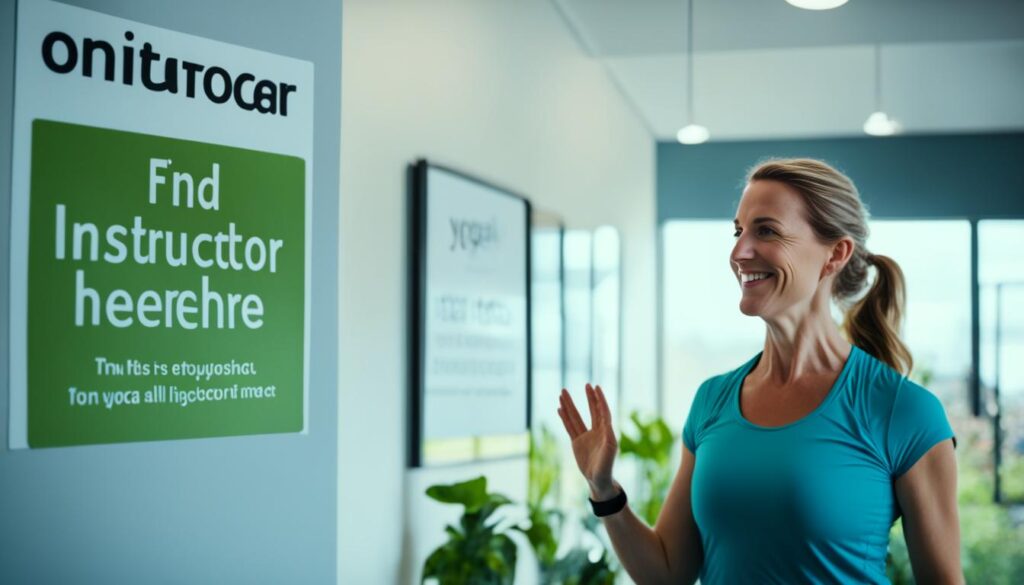
With these considerations in mind, you are now equipped to find the right yoga instructor and studio that resonates with your goals and aspirations. Remember, finding the perfect fit may take time, but the journey is worth it as you embark on a transformative and fulfilling yoga practice.
Yoga Poses for Every Level: A Guide to Start
Whether you’re a beginner or an advanced practitioner, this guide will provide you with a range of yoga poses suitable for your skill level. Yoga offers a variety of poses that can be adapted to meet your individual needs and physical abilities. By exploring these poses, you can enhance your strength and flexibility while enjoying the numerous benefits of yoga.
Adapting Yoga Poses for Your Skill Level
Adapting yoga poses to your skill level is crucial to ensure a safe and enjoyable practice. Start by understanding your body’s limitations and make modifications accordingly. If you’re a beginner, it’s essential to focus on building a strong foundation and proper alignment before attempting more advanced poses. Remember, yoga is a personal journey, and it’s perfectly okay to modify poses to suit your individual needs.
Here are some ways to adapt yoga poses for different skill levels:
- Use props such as blocks, bolsters, or straps to support your body and maintain proper alignment.
- Take modifications or variations of poses to make them more accessible or challenging, depending on your skill level.
- Listen to your body and honor its limits. Don’t push yourself into poses that feel painful or uncomfortable.
Yoga Sequences for Strength and Flexibility
To enhance your strength and flexibility through yoga, it’s essential to incorporate targeted sequences into your practice. These sequences combine specific poses to target different muscle groups and promote overall physical well-being.
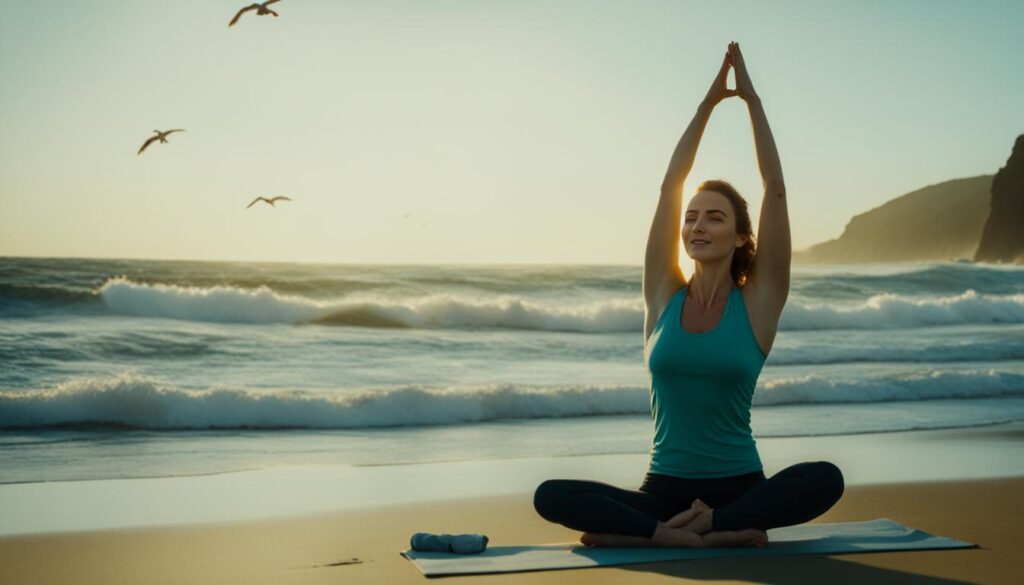
| Strength Sequence | Flexibility Sequence |
|---|---|
| 1. Downward Facing Dog | 1. Standing Forward Bend |
| 2. Plank Pose | 2. Cat-Cow Pose |
| 3. Warrior II Pose | 3. Triangle Pose |
| 4. Chair Pose | 4. Seated Forward Bend |
| 5. Bridge Pose | 5. Butterfly Pose |
| 6. Tree Pose | 6. Camel Pose |
These sequences are designed to target specific areas of the body, providing both strength-building and flexibility-enhancing benefits. Remember to warm up before attempting these sequences and always listen to your body to avoid overexertion or injury. With regular practice, you’ll notice significant improvements in both your strength and flexibility.
By incorporating these yoga poses and sequences into your practice, you can progress at your own pace and unlock your full potential on the mat. Remember to enjoy the journey and embrace the beauty of each pose as you find balance, strength, and flexibility.
Nourishing Your Body: The Yoga Way of Nutrition and Hydration
In the world of yoga, the importance of nourishing your body goes beyond physical postures and stretches. Yoga nutrition and hydration play a vital role in supporting your practice and enhancing overall well-being. In this section, we will delve into the principles of mindful eating and share tips on how to fuel your body with nutritious foods. We will also provide guidance on staying hydrated during and after your yoga sessions.
When it comes to yoga nutrition, the key is to embrace mindful eating. This means being present and fully aware of what you eat, making conscious choices that support your health and well-being. Mindful eating involves paying attention to your body’s hunger and fullness cues, honoring your cravings while prioritizing nourishing foods.

One of the fundamental principles of yoga nutrition is to focus on whole, unprocessed foods. Incorporate plenty of fresh fruits and vegetables, whole grains, lean proteins, and healthy fats into your diet. These foods provide essential nutrients, vitamins, and minerals that support your body’s needs and promote overall vitality. Aim for a balanced plate filled with a colorful array of nutrient-dense foods.
In addition to mindful eating, proper hydration is crucial for maintaining optimal physical and mental function during your yoga practice. Drinking enough water helps to regulate body temperature, lubricate joints, and support digestion. It is recommended to drink water before, during, and after your yoga sessions to stay hydrated.
During your practice, if you find yourself needing an extra boost of hydration, consider integrating hydrating foods into your diet. Water-rich fruits and vegetables, such as watermelon, cucumber, and oranges, can provide hydration while also delivering important vitamins and minerals.
To promote proper hydration, make it a habit to carry a reusable water bottle with you throughout the day. This will serve as a constant reminder to drink water and ensure you stay adequately hydrated, not just during your yoga practice, but throughout your daily routine.
By incorporating mindful eating and proper hydration into your yoga lifestyle, you can nourish your body from within, supporting your practice and overall well-being.
Creating the Perfect Yoga Space at Home
Transform your home into a serene sanctuary with a dedicated yoga space. Designing a harmonious environment for your home yoga practice is essential for cultivating a peaceful and focused mindset. In this section, we will provide you with tips on choosing the ideal equipment and accessories to enhance your home yoga practice. We will also explore how to set the perfect ambiance to create a calming and peaceful environment for your yoga sessions.
Choosing the Ideal Equipment and Accessories
When it comes to creating a yoga space at home, selecting the right equipment and accessories is crucial for a comfortable and enjoyable practice. Here are some essentials to consider:
- Yoga mat: Choose a high-quality yoga mat that provides adequate cushioning and grip to support your practice. Look for mats made of eco-friendly materials for a more sustainable choice.
- Props and accessories: Depending on your practice, consider incorporating props such as blocks, straps, and bolsters to assist with proper alignment and deepen your stretches.
- Comfortable clothing: Opt for breathable and stretchy clothing that allows for unrestricted movement during your yoga practice. This will enhance your comfort and enable you to fully immerse yourself in each pose.
“The right equipment and accessories enhance your comfort and allow you to fully immerse yourself in each pose.”
Setting the Ambiance for Yoga
Creating a calming and peaceful ambiance in your yoga space is essential for promoting relaxation and focus during your practice. Here are some tips to help you set the perfect ambiance:
- Lighting: Opt for soft and warm lighting, such as candles or dimmed lights, to create a serene atmosphere.
- Aromatherapy: Use essential oils or incense to infuse the space with soothing scents that promote relaxation and mindfulness.
- Music: Play gentle and calming music or nature sounds to create a tranquil auditory background for your practice.
- Declutter: Ensure your yoga space is free from clutter and distractions, allowing you to fully focus on your practice without any external disturbances.
By carefully selecting the ideal equipment and accessories and setting a calming ambiance, you can create a serene and inviting yoga space at home. This will enable you to fully immerse yourself in your practice and experience deep relaxation and rejuvenation.
| Equipment/Accessories | Description |
|---|---|
| Yoga Mat | A high-quality mat that provides cushioning and grip for a comfortable practice. |
| Props and Accessories | Blocks, straps, and bolsters to assist with alignment and enhance stretches. |
| Comfortable Clothing | Breathable and stretchy attire for unrestricted movement during practice. |
Incorporating Yoga Retreats into Your Lifestyle
Are you ready to take your yoga practice to the next level? Consider incorporating yoga retreats into your lifestyle. These getaways offer a unique opportunity to immerse yourself in the practice of yoga, disconnect from the daily hustle and bustle, and rejuvenate your mind, body, and spirit.
The Benefits of Yoga Getaways
Yoga retreats provide numerous benefits that go beyond a typical yoga class. Here are just a few benefits of embarking on a yoga getaway:
- Deep relaxation: Retreats offer a chance to detach from the stresses of daily life and immerse yourself in a tranquil environment.
- Self-reflection: Retreats provide a space for introspection and self-discovery, allowing you to gain a deeper understanding of yourself and your practice.
- Spiritual growth: By diving into a yoga retreat, you can explore the spiritual aspects of yoga and cultivate a deeper connection with your inner self.
- Community and connection: Yoga retreats bring together like-minded individuals, creating a sense of community and fostering new connections.
- Enhanced practice: With dedicated time and guidance from experienced instructors, you have the opportunity to refine and deepen your yoga practice.
Embarking on a yoga retreat is not only a chance to treat yourself but also an investment in your overall well-being. It’s a time to prioritize self-care and recharge, returning home with a renewed sense of energy and clarity.
Exploring Yoga Retreat Options for Deep Dive
When it comes to yoga retreats, there are countless options to choose from. Whether you’re seeking a serene beachside retreat, a mountain getaway, or a cultural immersion experience, there’s a retreat suited to your preferences and goals. Some popular types of yoga retreats include:
| Retreat Type | Description |
|---|---|
| Wellness Retreats | Focused on incorporating various holistic practices alongside yoga, such as meditation, Ayurveda, and spa treatments. |
| Nature Retreats | Immerse yourself in the beauty of nature while practicing yoga in serene and picturesque surroundings. |
| Cultural Retreats | Combine yoga with a cultural immersion experience, exploring unique destinations and immersing yourself in the local culture. |
| Adventure Retreats | Take your yoga practice to new heights with retreats that incorporate activities like hiking, surfing, or kayaking. |
When choosing a retreat, consider factors such as location, duration, style of yoga, and the qualifications and experience of the retreat leaders. Research retreat reviews, testimonials, and itineraries to find a retreat that aligns with your needs and desires.
Remember, a yoga retreat is not just a vacation; it’s an opportunity to deepen your practice, connect with like-minded individuals, and recharge your body and mind. So, pack your yoga mat, leave your worries behind, and embark on a transformative journey through a yoga retreat.
Enrolling in Yoga Teacher Training: A Journey to Self-Discovery
Embarking on the path of becoming a yoga teacher is not just a professional endeavor; it is also a transformative journey of self-discovery. Yoga teacher training goes beyond learning how to teach asanas and sequences; it invites personal growth and provides a space for deep exploration of oneself.
During yoga teacher training, aspiring teachers delve into the philosophy and principles of yoga, gaining a profound understanding of the mind-body connection. Through intense practice and self-reflection, they develop a stronger sense of self-awareness and learn to embody the teachings of yoga in their own lives.
Aspiring yoga teachers have the opportunity to learn from experienced and knowledgeable instructors who guide them through this transformative process. These teachers serve as mentors, providing guidance, support, and empowering their students to find their unique voice as yoga teachers.
The journey of becoming a certified yoga teacher is not only about gaining technical skills; it also involves personal growth and transformation. Through the processes of self-study, reflection, and introspection, individuals discover new aspects of themselves, unlocking their potential and finding a deeper connection to their own inner wisdom.
There are various yoga teacher training programs available, each offering a unique approach and emphasis. It is essential to choose a program that aligns with your intentions and goals. Whether you seek to deepen your personal practice or pursue a career as a yoga teacher, selecting a program that resonates with you is crucial for an enriching and fulfilling experience.
| Key Considerations for Choosing a Yoga Teacher Training Program |
|---|
| 1. Certification: Ensure that the program is accredited by a reputable yoga alliance or organization. |
| 2. Duration and Intensity: Determine whether you prefer an immersive residential program or a part-time program that spans several months. |
| 3. Curriculum: Assess the program’s curriculum and ensure it covers the necessary topics, such as yoga philosophy, anatomy, teaching methodology, and practical teaching experience. |
| 4. Teacher Qualifications: Research the credentials and experience of the lead teachers to ensure they have a comprehensive understanding of yoga and the ability to guide students effectively. |
| 5. Reviews and Testimonials: Seek feedback from past program participants to gain insight into their experiences and the program’s effectiveness. |
| 6. Cost and Location: Consider the program’s cost and location, ensuring they align with your budget and ability to attend in person or online. |
Enrolling in yoga teacher training is not only a commitment to becoming a yoga teacher but also an investment in personal growth and self-discovery. It is a transformative journey that empowers individuals to embody the teachings of yoga, share their knowledge with others, and make a positive impact in the world.
Conclusion: Integrating Yoga into Your Daily Life for Lasting Change
As we reach the end of our journey through the transformative world of yoga, it’s time to reflect on the significance of integrating this ancient practice into your daily life. By understanding its key benefits and essentials, you can embark on a path of lasting change and holistic well-being.
Throughout this article, we have explored how yoga can enhance your physical, mental, and emotional well-being. From improved strength and flexibility to reduced stress and increased mental clarity, the benefits of yoga are truly remarkable. By incorporating yoga into your daily routine, you can experience a positive and transformative shift in your life.
To help you integrate yoga into your day-to-day activities, we offer a few practical tips. Begin by setting aside dedicated time for your yoga practice, whether it’s in the morning, during your lunch break, or in the evening. Create a peaceful and calming space in your home where you can practice yoga without distractions. Remember that consistency is key, so aim to make yoga a regular part of your routine.
Embracing yoga as a lifestyle goes beyond the physical poses; it’s about cultivating mindfulness, finding inner peace, and nourishing your body and mind. By incorporating yoga into your daily life, you open doors to self-discovery and ongoing personal growth. So, take that first step and let the transformative power of yoga guide you towards a life of lasting change and holistic well-being.

